A Report on Adult Obesity: Problem, Solutions, and Stakeholders
VerifiedAdded on 2021/06/14
|10
|1478
|56
Report
AI Summary
This report addresses the significant issue of adult obesity in the United States, defining it as a basal mass index (BMI) over 30 kg/m2 and highlighting its associated health risks like cardiovascular disorders and depression. The report explores the problem's prevalence, attributing it to sedentary lifestyles and processed food consumption, with statistics showing over a third of the adult population affected. Proposed solutions include lifestyle modifications (diet and exercise), pharmacological interventions, aggressive health education, and BMI screening. The report justifies these solutions, detailing implementation strategies, required resources involving government, hospitals, schools, and media, and timelines. It emphasizes the roles of stakeholders such as the government, nursing schools, and the media in ensuring effective implementation. The nurse's role is also highlighted as that of a scientist, detective, and manager in addressing and resolving the problem of adult obesity. The report concludes with a bibliography of cited sources.
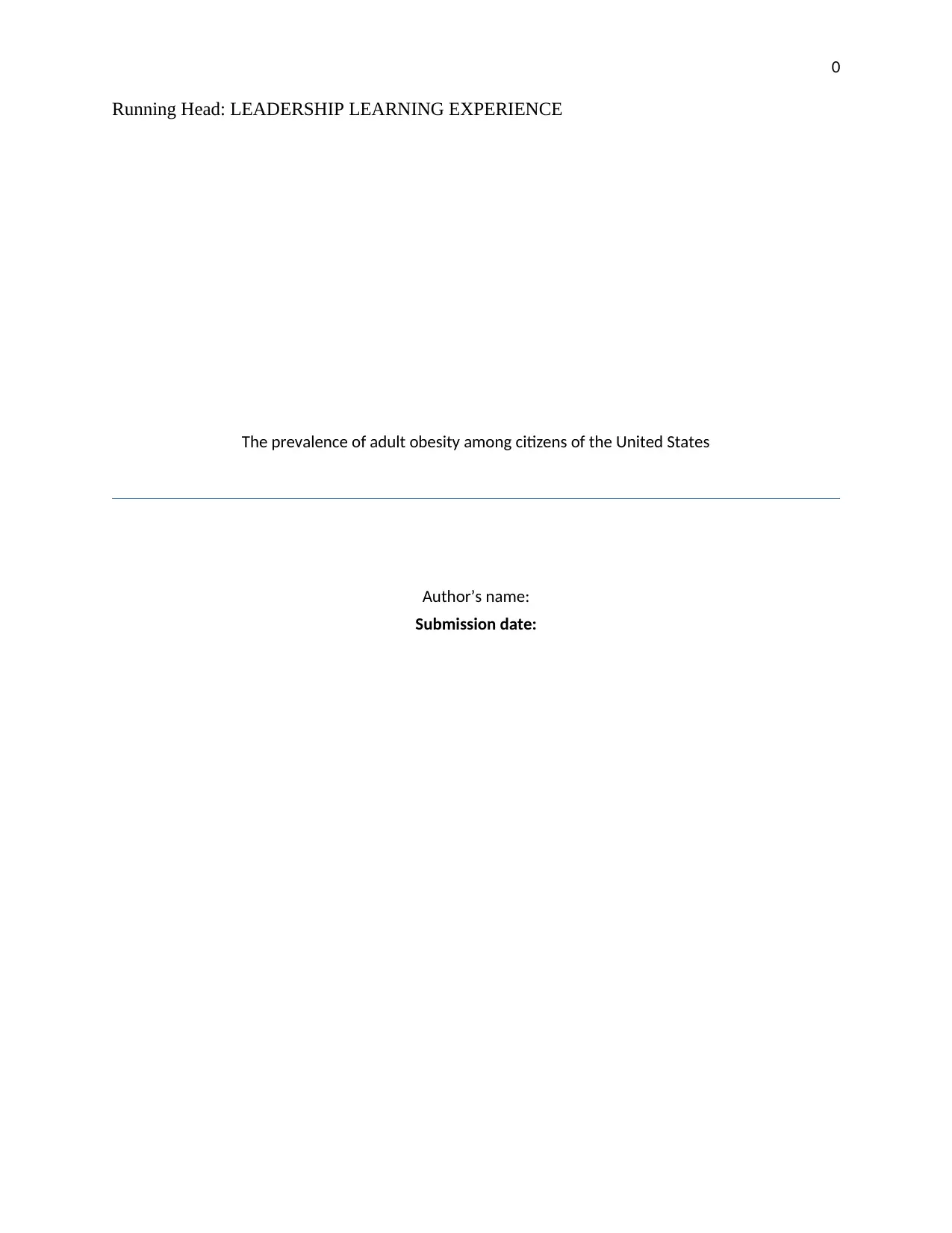
0
Running Head: LEADERSHIP LEARNING EXPERIENCE
The prevalence of adult obesity among citizens of the United States
Author’s name:
Submission date:
Running Head: LEADERSHIP LEARNING EXPERIENCE
The prevalence of adult obesity among citizens of the United States
Author’s name:
Submission date:
Paraphrase This Document
Need a fresh take? Get an instant paraphrase of this document with our AI Paraphraser
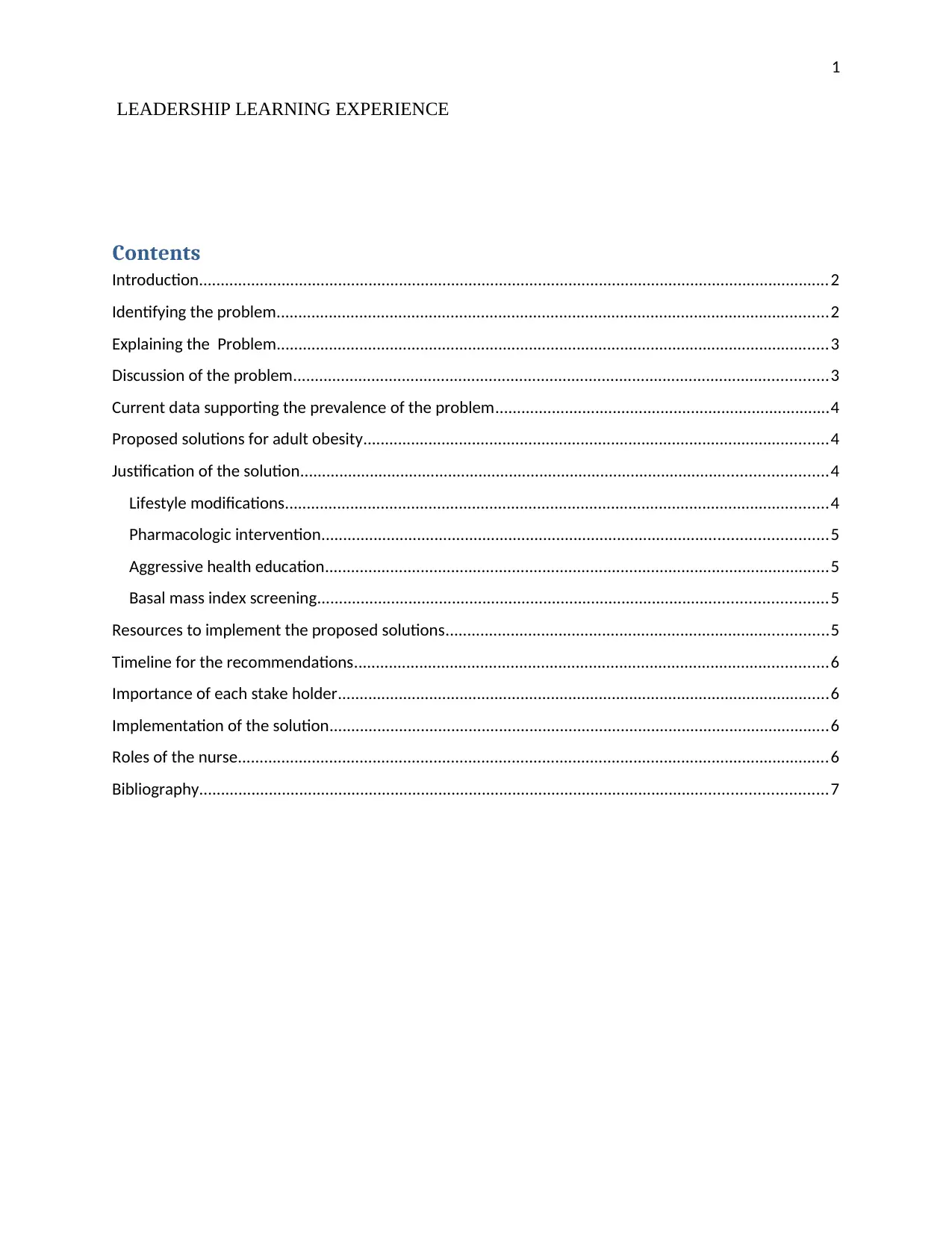
1
LEADERSHIP LEARNING EXPERIENCE
Contents
Introduction.................................................................................................................................................2
Identifying the problem...............................................................................................................................2
Explaining the Problem...............................................................................................................................3
Discussion of the problem...........................................................................................................................3
Current data supporting the prevalence of the problem.............................................................................4
Proposed solutions for adult obesity...........................................................................................................4
Justification of the solution.........................................................................................................................4
Lifestyle modifications.............................................................................................................................4
Pharmacologic intervention....................................................................................................................5
Aggressive health education....................................................................................................................5
Basal mass index screening.....................................................................................................................5
Resources to implement the proposed solutions........................................................................................5
Timeline for the recommendations.............................................................................................................6
Importance of each stake holder.................................................................................................................6
Implementation of the solution...................................................................................................................6
Roles of the nurse........................................................................................................................................6
Bibliography................................................................................................................................................7
LEADERSHIP LEARNING EXPERIENCE
Contents
Introduction.................................................................................................................................................2
Identifying the problem...............................................................................................................................2
Explaining the Problem...............................................................................................................................3
Discussion of the problem...........................................................................................................................3
Current data supporting the prevalence of the problem.............................................................................4
Proposed solutions for adult obesity...........................................................................................................4
Justification of the solution.........................................................................................................................4
Lifestyle modifications.............................................................................................................................4
Pharmacologic intervention....................................................................................................................5
Aggressive health education....................................................................................................................5
Basal mass index screening.....................................................................................................................5
Resources to implement the proposed solutions........................................................................................5
Timeline for the recommendations.............................................................................................................6
Importance of each stake holder.................................................................................................................6
Implementation of the solution...................................................................................................................6
Roles of the nurse........................................................................................................................................6
Bibliography................................................................................................................................................7
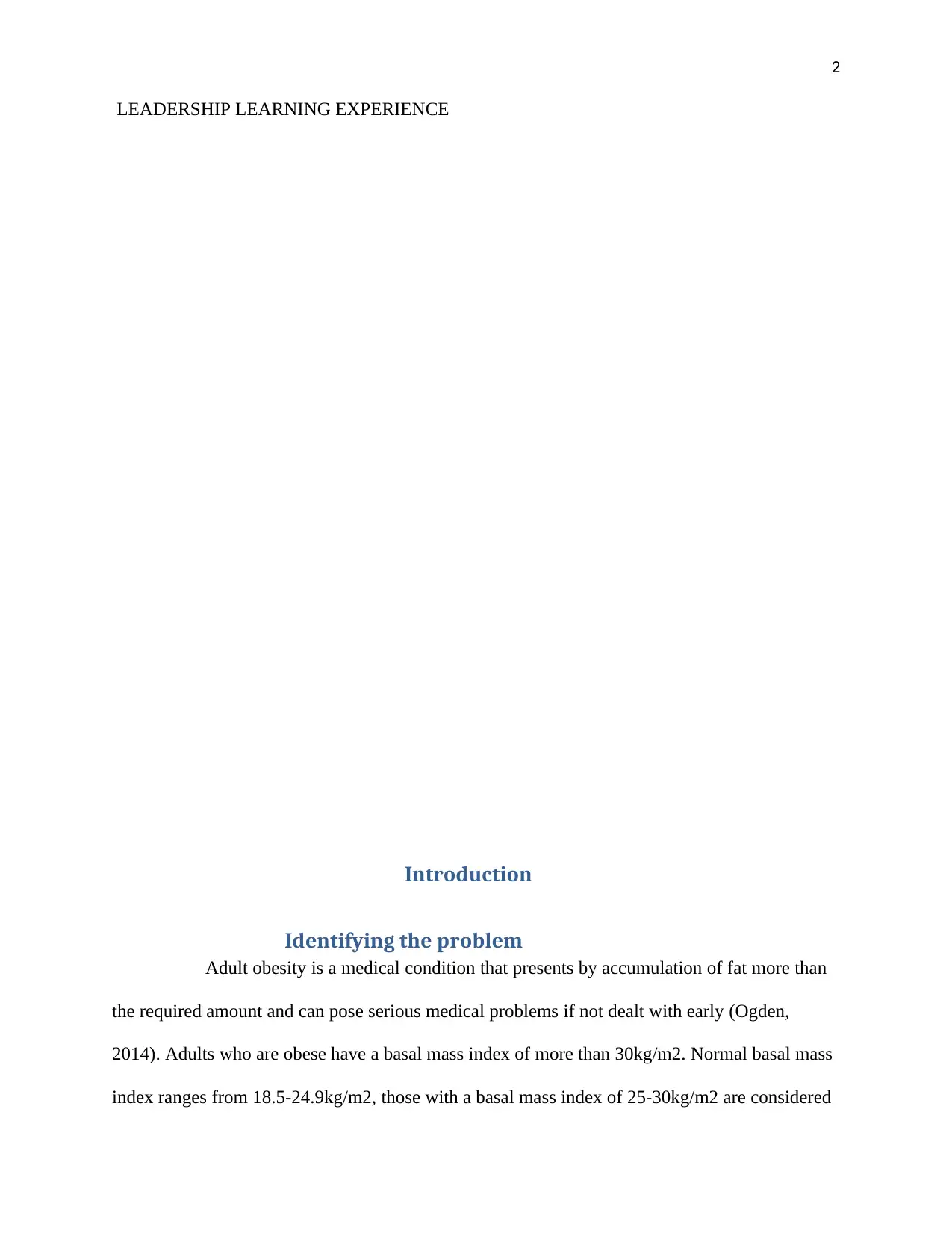
2
LEADERSHIP LEARNING EXPERIENCE
Introduction
Identifying the problem
Adult obesity is a medical condition that presents by accumulation of fat more than
the required amount and can pose serious medical problems if not dealt with early (Ogden,
2014). Adults who are obese have a basal mass index of more than 30kg/m2. Normal basal mass
index ranges from 18.5-24.9kg/m2, those with a basal mass index of 25-30kg/m2 are considered
LEADERSHIP LEARNING EXPERIENCE
Introduction
Identifying the problem
Adult obesity is a medical condition that presents by accumulation of fat more than
the required amount and can pose serious medical problems if not dealt with early (Ogden,
2014). Adults who are obese have a basal mass index of more than 30kg/m2. Normal basal mass
index ranges from 18.5-24.9kg/m2, those with a basal mass index of 25-30kg/m2 are considered
⊘ This is a preview!⊘
Do you want full access?
Subscribe today to unlock all pages.

Trusted by 1+ million students worldwide
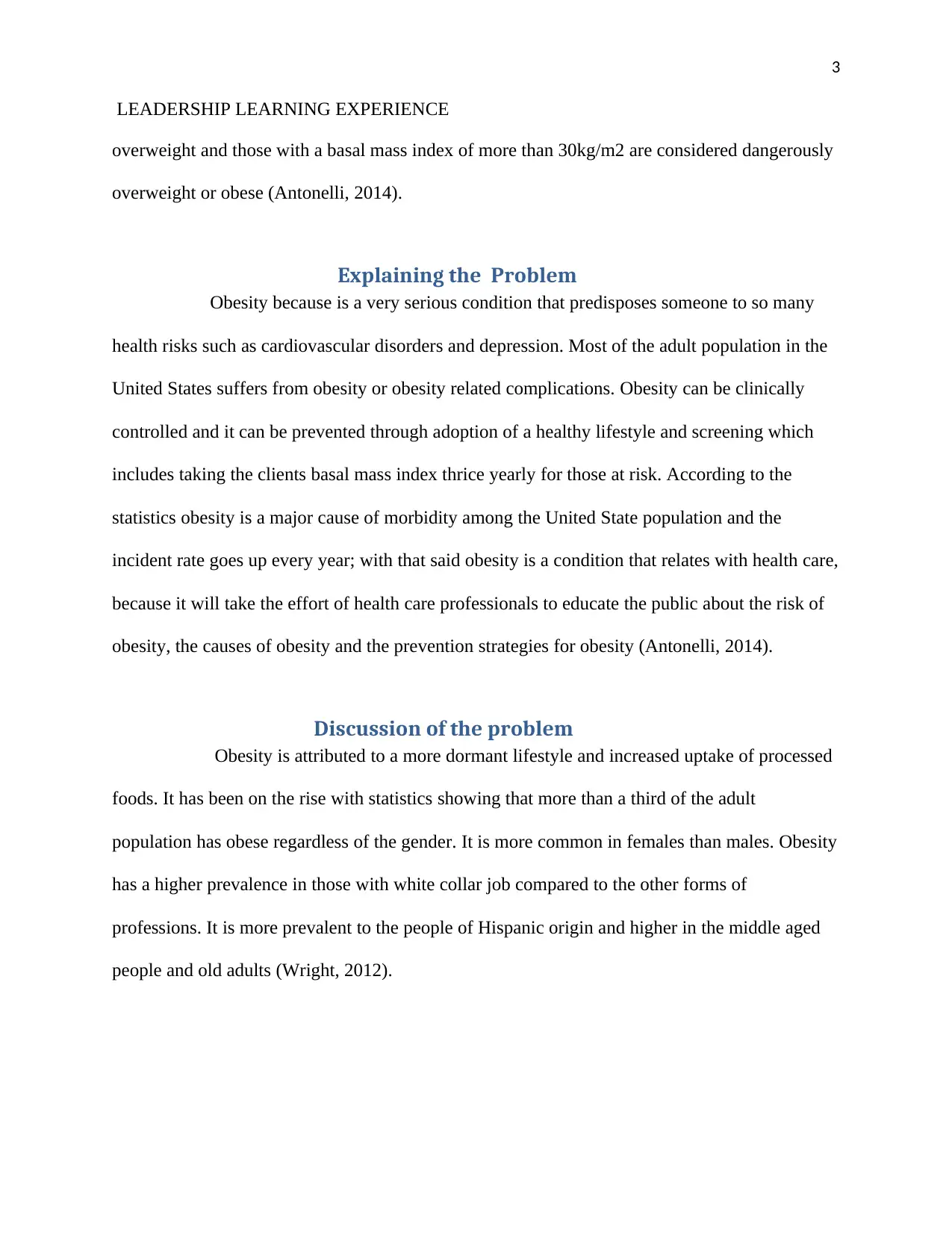
3
LEADERSHIP LEARNING EXPERIENCE
overweight and those with a basal mass index of more than 30kg/m2 are considered dangerously
overweight or obese (Antonelli, 2014).
Explaining the Problem
Obesity because is a very serious condition that predisposes someone to so many
health risks such as cardiovascular disorders and depression. Most of the adult population in the
United States suffers from obesity or obesity related complications. Obesity can be clinically
controlled and it can be prevented through adoption of a healthy lifestyle and screening which
includes taking the clients basal mass index thrice yearly for those at risk. According to the
statistics obesity is a major cause of morbidity among the United State population and the
incident rate goes up every year; with that said obesity is a condition that relates with health care,
because it will take the effort of health care professionals to educate the public about the risk of
obesity, the causes of obesity and the prevention strategies for obesity (Antonelli, 2014).
Discussion of the problem
Obesity is attributed to a more dormant lifestyle and increased uptake of processed
foods. It has been on the rise with statistics showing that more than a third of the adult
population has obese regardless of the gender. It is more common in females than males. Obesity
has a higher prevalence in those with white collar job compared to the other forms of
professions. It is more prevalent to the people of Hispanic origin and higher in the middle aged
people and old adults (Wright, 2012).
LEADERSHIP LEARNING EXPERIENCE
overweight and those with a basal mass index of more than 30kg/m2 are considered dangerously
overweight or obese (Antonelli, 2014).
Explaining the Problem
Obesity because is a very serious condition that predisposes someone to so many
health risks such as cardiovascular disorders and depression. Most of the adult population in the
United States suffers from obesity or obesity related complications. Obesity can be clinically
controlled and it can be prevented through adoption of a healthy lifestyle and screening which
includes taking the clients basal mass index thrice yearly for those at risk. According to the
statistics obesity is a major cause of morbidity among the United State population and the
incident rate goes up every year; with that said obesity is a condition that relates with health care,
because it will take the effort of health care professionals to educate the public about the risk of
obesity, the causes of obesity and the prevention strategies for obesity (Antonelli, 2014).
Discussion of the problem
Obesity is attributed to a more dormant lifestyle and increased uptake of processed
foods. It has been on the rise with statistics showing that more than a third of the adult
population has obese regardless of the gender. It is more common in females than males. Obesity
has a higher prevalence in those with white collar job compared to the other forms of
professions. It is more prevalent to the people of Hispanic origin and higher in the middle aged
people and old adults (Wright, 2012).
Paraphrase This Document
Need a fresh take? Get an instant paraphrase of this document with our AI Paraphraser
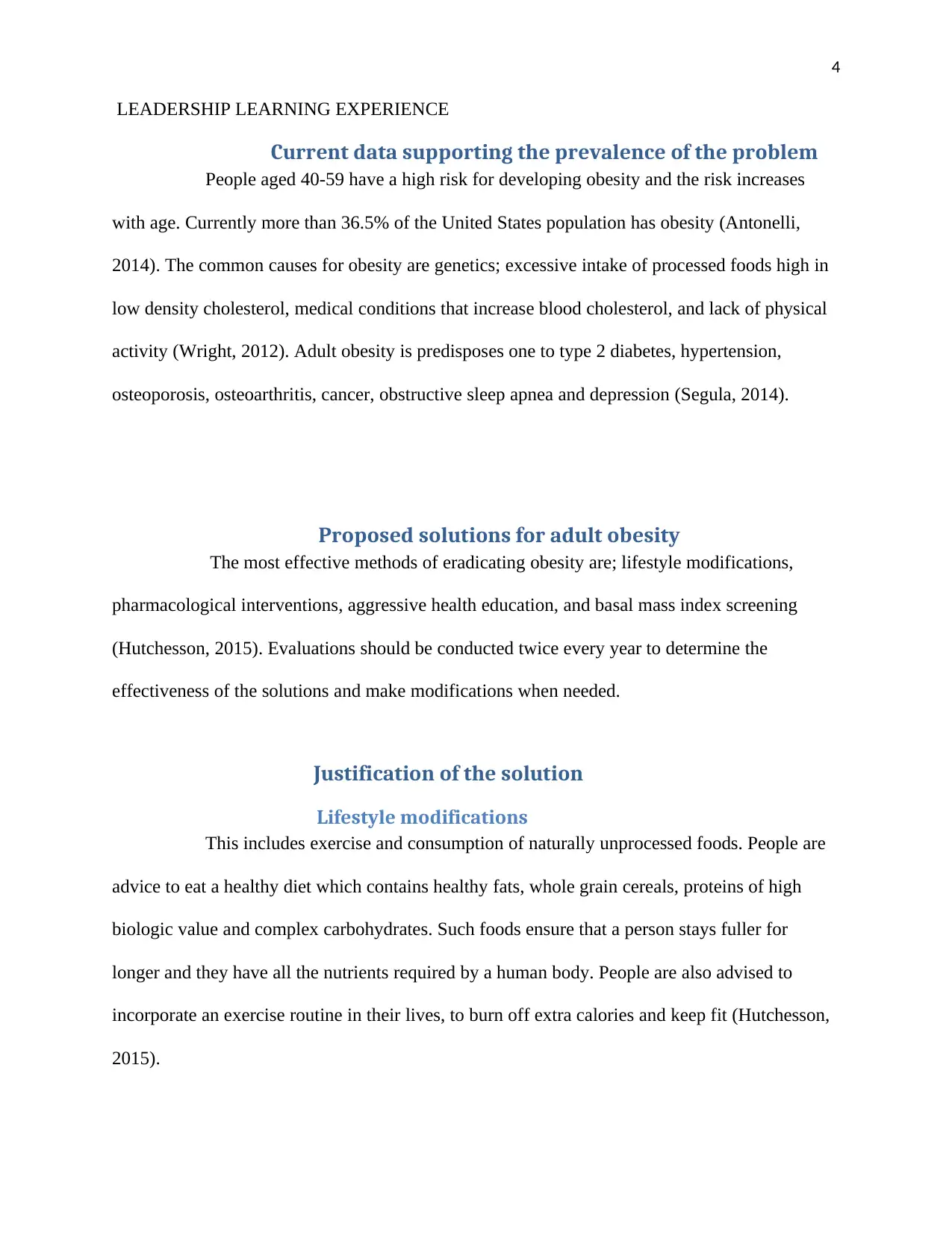
4
LEADERSHIP LEARNING EXPERIENCE
Current data supporting the prevalence of the problem
People aged 40-59 have a high risk for developing obesity and the risk increases
with age. Currently more than 36.5% of the United States population has obesity (Antonelli,
2014). The common causes for obesity are genetics; excessive intake of processed foods high in
low density cholesterol, medical conditions that increase blood cholesterol, and lack of physical
activity (Wright, 2012). Adult obesity is predisposes one to type 2 diabetes, hypertension,
osteoporosis, osteoarthritis, cancer, obstructive sleep apnea and depression (Segula, 2014).
Proposed solutions for adult obesity
The most effective methods of eradicating obesity are; lifestyle modifications,
pharmacological interventions, aggressive health education, and basal mass index screening
(Hutchesson, 2015). Evaluations should be conducted twice every year to determine the
effectiveness of the solutions and make modifications when needed.
Justification of the solution
Lifestyle modifications
This includes exercise and consumption of naturally unprocessed foods. People are
advice to eat a healthy diet which contains healthy fats, whole grain cereals, proteins of high
biologic value and complex carbohydrates. Such foods ensure that a person stays fuller for
longer and they have all the nutrients required by a human body. People are also advised to
incorporate an exercise routine in their lives, to burn off extra calories and keep fit (Hutchesson,
2015).
LEADERSHIP LEARNING EXPERIENCE
Current data supporting the prevalence of the problem
People aged 40-59 have a high risk for developing obesity and the risk increases
with age. Currently more than 36.5% of the United States population has obesity (Antonelli,
2014). The common causes for obesity are genetics; excessive intake of processed foods high in
low density cholesterol, medical conditions that increase blood cholesterol, and lack of physical
activity (Wright, 2012). Adult obesity is predisposes one to type 2 diabetes, hypertension,
osteoporosis, osteoarthritis, cancer, obstructive sleep apnea and depression (Segula, 2014).
Proposed solutions for adult obesity
The most effective methods of eradicating obesity are; lifestyle modifications,
pharmacological interventions, aggressive health education, and basal mass index screening
(Hutchesson, 2015). Evaluations should be conducted twice every year to determine the
effectiveness of the solutions and make modifications when needed.
Justification of the solution
Lifestyle modifications
This includes exercise and consumption of naturally unprocessed foods. People are
advice to eat a healthy diet which contains healthy fats, whole grain cereals, proteins of high
biologic value and complex carbohydrates. Such foods ensure that a person stays fuller for
longer and they have all the nutrients required by a human body. People are also advised to
incorporate an exercise routine in their lives, to burn off extra calories and keep fit (Hutchesson,
2015).
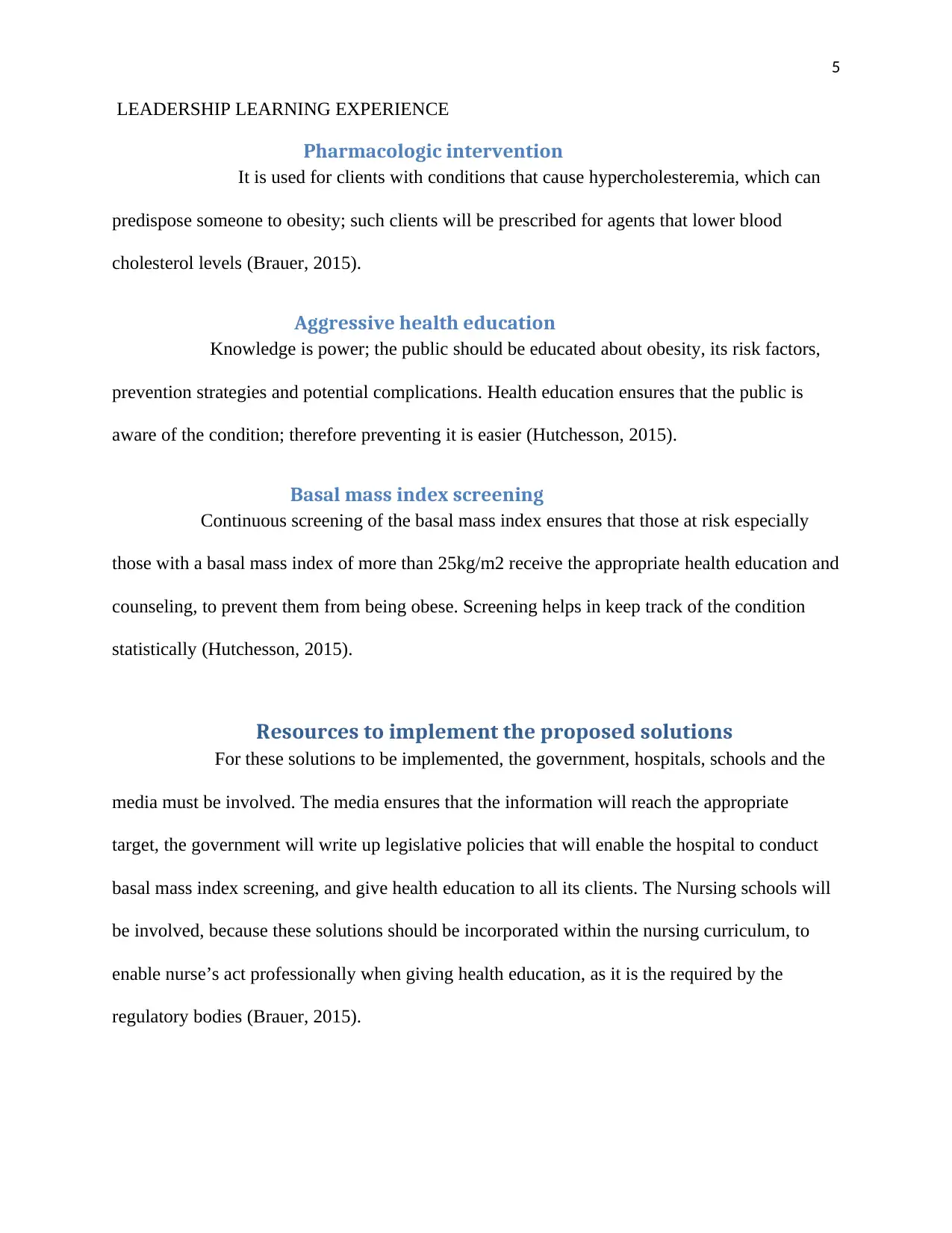
5
LEADERSHIP LEARNING EXPERIENCE
Pharmacologic intervention
It is used for clients with conditions that cause hypercholesteremia, which can
predispose someone to obesity; such clients will be prescribed for agents that lower blood
cholesterol levels (Brauer, 2015).
Aggressive health education
Knowledge is power; the public should be educated about obesity, its risk factors,
prevention strategies and potential complications. Health education ensures that the public is
aware of the condition; therefore preventing it is easier (Hutchesson, 2015).
Basal mass index screening
Continuous screening of the basal mass index ensures that those at risk especially
those with a basal mass index of more than 25kg/m2 receive the appropriate health education and
counseling, to prevent them from being obese. Screening helps in keep track of the condition
statistically (Hutchesson, 2015).
Resources to implement the proposed solutions
For these solutions to be implemented, the government, hospitals, schools and the
media must be involved. The media ensures that the information will reach the appropriate
target, the government will write up legislative policies that will enable the hospital to conduct
basal mass index screening, and give health education to all its clients. The Nursing schools will
be involved, because these solutions should be incorporated within the nursing curriculum, to
enable nurse’s act professionally when giving health education, as it is the required by the
regulatory bodies (Brauer, 2015).
LEADERSHIP LEARNING EXPERIENCE
Pharmacologic intervention
It is used for clients with conditions that cause hypercholesteremia, which can
predispose someone to obesity; such clients will be prescribed for agents that lower blood
cholesterol levels (Brauer, 2015).
Aggressive health education
Knowledge is power; the public should be educated about obesity, its risk factors,
prevention strategies and potential complications. Health education ensures that the public is
aware of the condition; therefore preventing it is easier (Hutchesson, 2015).
Basal mass index screening
Continuous screening of the basal mass index ensures that those at risk especially
those with a basal mass index of more than 25kg/m2 receive the appropriate health education and
counseling, to prevent them from being obese. Screening helps in keep track of the condition
statistically (Hutchesson, 2015).
Resources to implement the proposed solutions
For these solutions to be implemented, the government, hospitals, schools and the
media must be involved. The media ensures that the information will reach the appropriate
target, the government will write up legislative policies that will enable the hospital to conduct
basal mass index screening, and give health education to all its clients. The Nursing schools will
be involved, because these solutions should be incorporated within the nursing curriculum, to
enable nurse’s act professionally when giving health education, as it is the required by the
regulatory bodies (Brauer, 2015).
⊘ This is a preview!⊘
Do you want full access?
Subscribe today to unlock all pages.

Trusted by 1+ million students worldwide
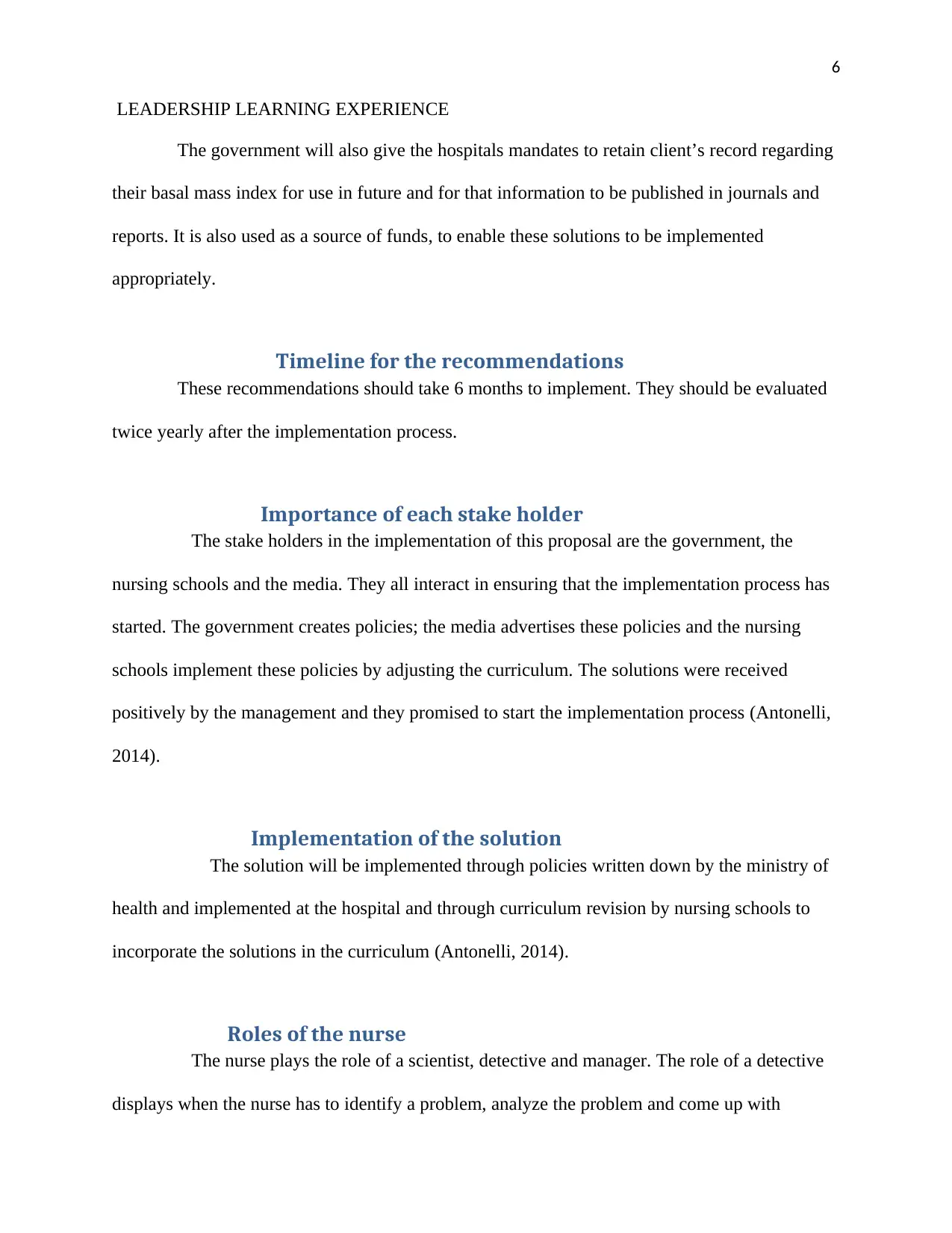
6
LEADERSHIP LEARNING EXPERIENCE
The government will also give the hospitals mandates to retain client’s record regarding
their basal mass index for use in future and for that information to be published in journals and
reports. It is also used as a source of funds, to enable these solutions to be implemented
appropriately.
Timeline for the recommendations
These recommendations should take 6 months to implement. They should be evaluated
twice yearly after the implementation process.
Importance of each stake holder
The stake holders in the implementation of this proposal are the government, the
nursing schools and the media. They all interact in ensuring that the implementation process has
started. The government creates policies; the media advertises these policies and the nursing
schools implement these policies by adjusting the curriculum. The solutions were received
positively by the management and they promised to start the implementation process (Antonelli,
2014).
Implementation of the solution
The solution will be implemented through policies written down by the ministry of
health and implemented at the hospital and through curriculum revision by nursing schools to
incorporate the solutions in the curriculum (Antonelli, 2014).
Roles of the nurse
The nurse plays the role of a scientist, detective and manager. The role of a detective
displays when the nurse has to identify a problem, analyze the problem and come up with
LEADERSHIP LEARNING EXPERIENCE
The government will also give the hospitals mandates to retain client’s record regarding
their basal mass index for use in future and for that information to be published in journals and
reports. It is also used as a source of funds, to enable these solutions to be implemented
appropriately.
Timeline for the recommendations
These recommendations should take 6 months to implement. They should be evaluated
twice yearly after the implementation process.
Importance of each stake holder
The stake holders in the implementation of this proposal are the government, the
nursing schools and the media. They all interact in ensuring that the implementation process has
started. The government creates policies; the media advertises these policies and the nursing
schools implement these policies by adjusting the curriculum. The solutions were received
positively by the management and they promised to start the implementation process (Antonelli,
2014).
Implementation of the solution
The solution will be implemented through policies written down by the ministry of
health and implemented at the hospital and through curriculum revision by nursing schools to
incorporate the solutions in the curriculum (Antonelli, 2014).
Roles of the nurse
The nurse plays the role of a scientist, detective and manager. The role of a detective
displays when the nurse has to identify a problem, analyze the problem and come up with
Paraphrase This Document
Need a fresh take? Get an instant paraphrase of this document with our AI Paraphraser
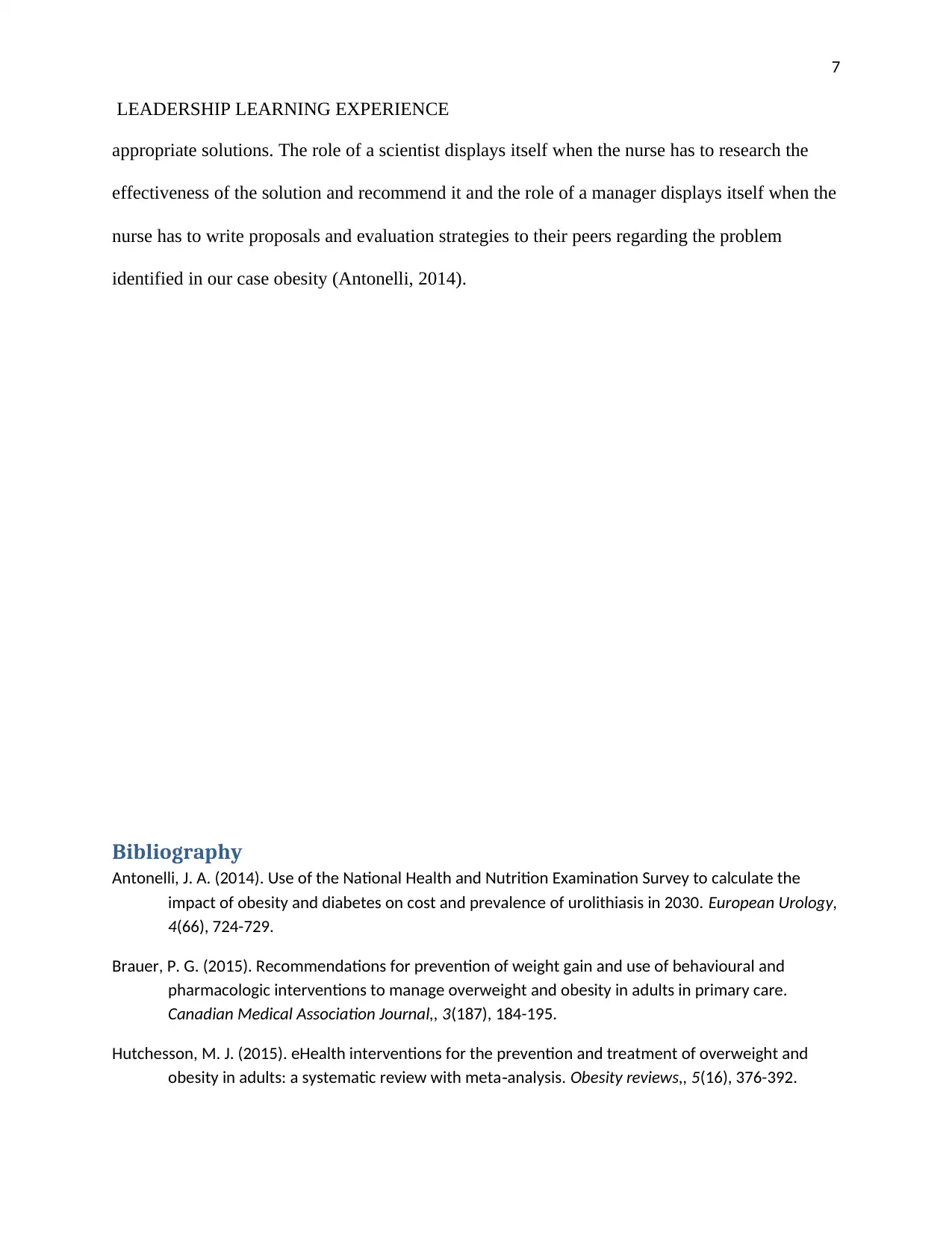
7
LEADERSHIP LEARNING EXPERIENCE
appropriate solutions. The role of a scientist displays itself when the nurse has to research the
effectiveness of the solution and recommend it and the role of a manager displays itself when the
nurse has to write proposals and evaluation strategies to their peers regarding the problem
identified in our case obesity (Antonelli, 2014).
Bibliography
Antonelli, J. A. (2014). Use of the National Health and Nutrition Examination Survey to calculate the
impact of obesity and diabetes on cost and prevalence of urolithiasis in 2030. European Urology,
4(66), 724-729.
Brauer, P. G. (2015). Recommendations for prevention of weight gain and use of behavioural and
pharmacologic interventions to manage overweight and obesity in adults in primary care.
Canadian Medical Association Journal,, 3(187), 184-195.
Hutchesson, M. J. (2015). eHealth interventions for the prevention and treatment of overweight and
obesity in adults: a systematic review with meta analysis.‐ Obesity reviews,, 5(16), 376-392.
LEADERSHIP LEARNING EXPERIENCE
appropriate solutions. The role of a scientist displays itself when the nurse has to research the
effectiveness of the solution and recommend it and the role of a manager displays itself when the
nurse has to write proposals and evaluation strategies to their peers regarding the problem
identified in our case obesity (Antonelli, 2014).
Bibliography
Antonelli, J. A. (2014). Use of the National Health and Nutrition Examination Survey to calculate the
impact of obesity and diabetes on cost and prevalence of urolithiasis in 2030. European Urology,
4(66), 724-729.
Brauer, P. G. (2015). Recommendations for prevention of weight gain and use of behavioural and
pharmacologic interventions to manage overweight and obesity in adults in primary care.
Canadian Medical Association Journal,, 3(187), 184-195.
Hutchesson, M. J. (2015). eHealth interventions for the prevention and treatment of overweight and
obesity in adults: a systematic review with meta analysis.‐ Obesity reviews,, 5(16), 376-392.
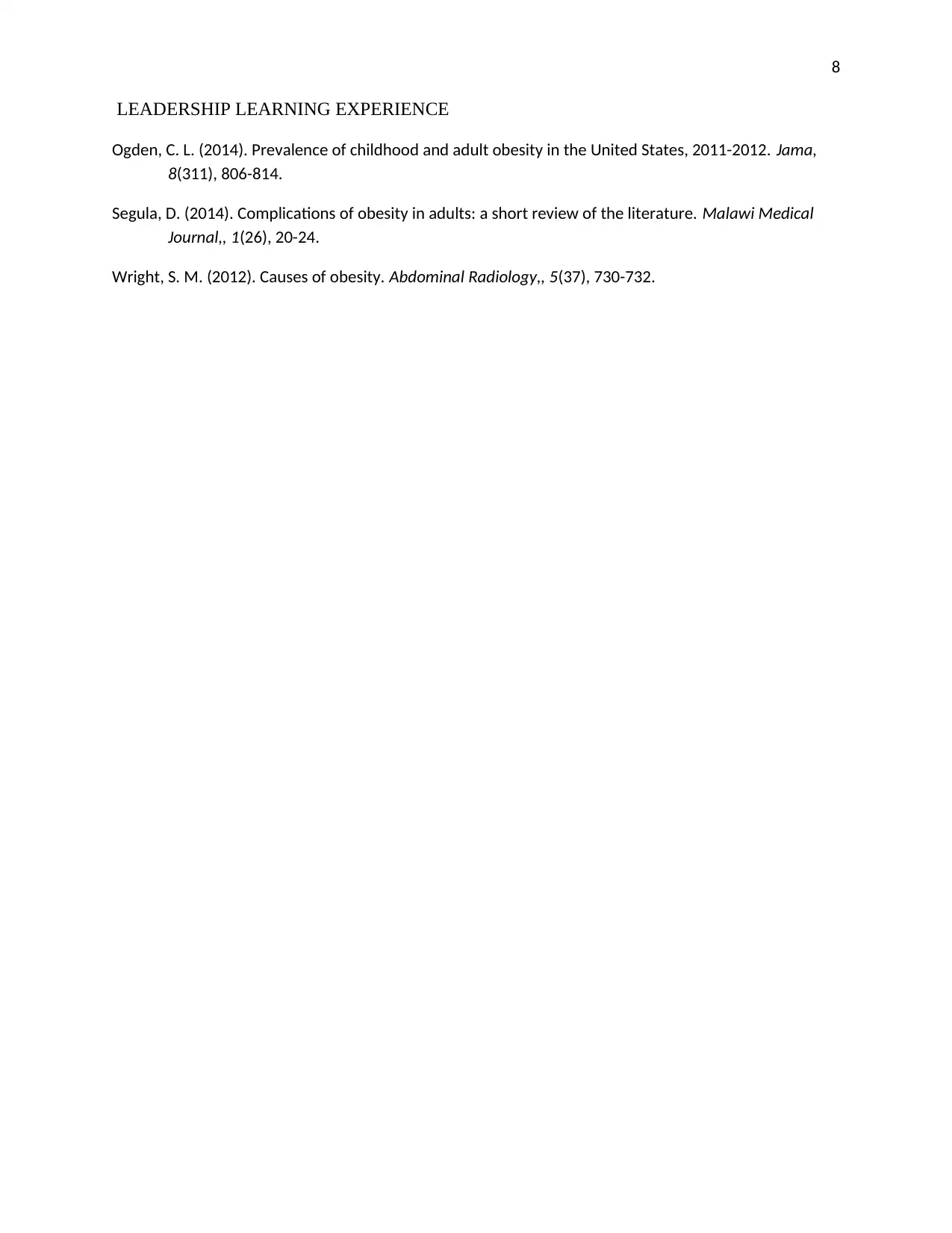
8
LEADERSHIP LEARNING EXPERIENCE
Ogden, C. L. (2014). Prevalence of childhood and adult obesity in the United States, 2011-2012. Jama,
8(311), 806-814.
Segula, D. (2014). Complications of obesity in adults: a short review of the literature. Malawi Medical
Journal,, 1(26), 20-24.
Wright, S. M. (2012). Causes of obesity. Abdominal Radiology,, 5(37), 730-732.
LEADERSHIP LEARNING EXPERIENCE
Ogden, C. L. (2014). Prevalence of childhood and adult obesity in the United States, 2011-2012. Jama,
8(311), 806-814.
Segula, D. (2014). Complications of obesity in adults: a short review of the literature. Malawi Medical
Journal,, 1(26), 20-24.
Wright, S. M. (2012). Causes of obesity. Abdominal Radiology,, 5(37), 730-732.
⊘ This is a preview!⊘
Do you want full access?
Subscribe today to unlock all pages.

Trusted by 1+ million students worldwide
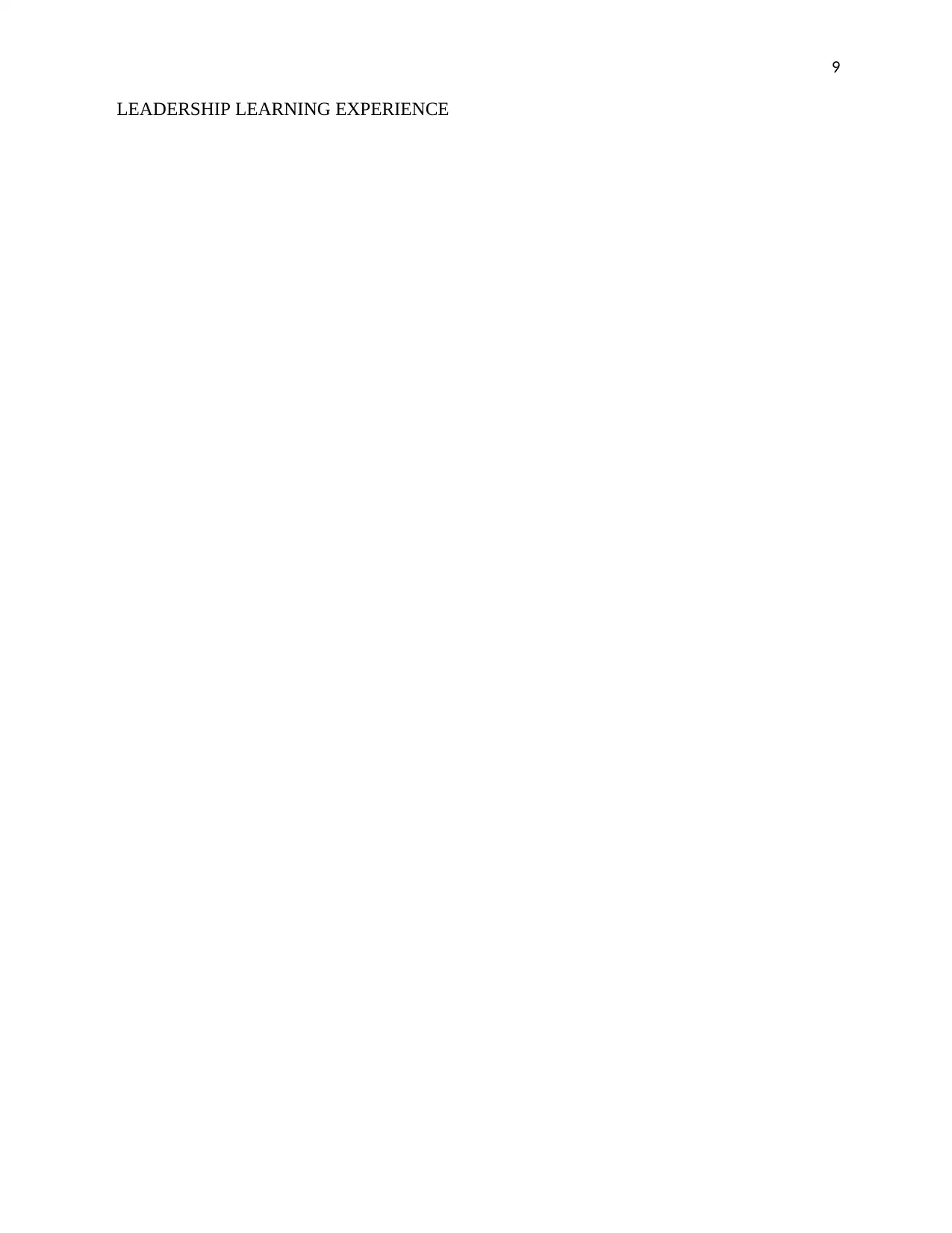
9
LEADERSHIP LEARNING EXPERIENCE
LEADERSHIP LEARNING EXPERIENCE
1 out of 10
Related Documents
Your All-in-One AI-Powered Toolkit for Academic Success.
+13062052269
info@desklib.com
Available 24*7 on WhatsApp / Email
![[object Object]](/_next/static/media/star-bottom.7253800d.svg)
Unlock your academic potential
Copyright © 2020–2025 A2Z Services. All Rights Reserved. Developed and managed by ZUCOL.





